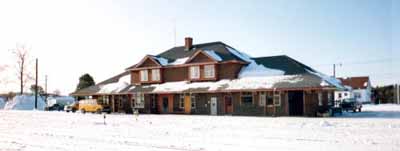Canadian Pacific Railway Station
Heritage Railway Station of Canada
Cartier, Ontario

Exterior photo
(© (Murray Peterson, 1993.))
Address :
Spencer Avenue, Cartier, Ontario
Recognition Statute:
Heritage Railway Stations Protection Act (R.S.C., 1985, c. 52 (4th Supp.))
Designation Date:
1993-03-10
Dates:
-
1910 to 1910
(Construction)
-
1948 to 1948
(Significant)
Research Report Number:
RS-192
Description of Historic Place
The Canadian Pacific Railway Station at Cartier is a one-and-a-half-storey railway station, built in 1910 and extensively renovated in 1948. It is located within extensive rail yards in the small northern Ontario community of Cartier. The formal recognition is confined to the railway station building itself.
Heritage Value
The Canadian Pacific Railway (CPR) Station at Cartier reflects the turn-of-the-century prosperity of the CPR and its pre-World War I program to replace existing facilities with larger and more elegant stations. The construction of improved facilities at Cartier reflects the importance of this divisional point to the CPR, and pivotal role of the railway in the town’s economic security.
The Cartier railway station reflects an extensive 1948 renovation to the original 1910 structure. The renovated structure continues to incorporate typical features of early-20th-century, rural CPR stations of medium size.
The station retains its relationship to the extensive rail yards and continues to be visually dominant within the rail yards and the townscape.
Sources: Heritage Character Statement, Canadian Pacific Railway Station, Cartier, Ontario, March 1994; Murray Peterson, Railway Station Report 192, Canadian Pacific Railway Station, Cartier, Ontario.
Character-Defining Elements
Character-defining elements of Canadian Pacific Railway Station at Cartier include: its long, low massing, consisting of a two-storey central block with a low-pitched hip roof and pedimented dormers (two on the track side and one on the town side) and one-storey wings with low-pitched hip roofs its horizontality, evident in the long hip roofs and wide overhanging eave elements typical of early-20th-century, rural railway stations, including the wide, overhanging eave forming a platform canopy along the track elevation and extending partway along the ends of the building, over-scale wooden brackets supporting the eave and the projecting operator’s bay on the track side the arrangement of window and door openings in groups of two or three the small scale and simplicity of the door openings, and of the multi-paned rectangular windows set in plain frames surviving original window units with transoms and plain wood frames its interior plan, consisting of three separate areas: the east end waiting room, the central office space and the west end general office and activity space surviving original interior fixtures and features in the waiting room, including high ceilings, light fixtures, window trim and wooden benches.